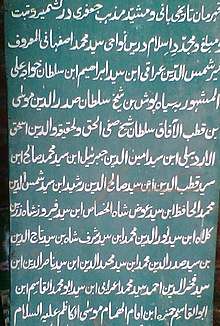Mir Shams-ud-Din Araqi
Mir Syed Mohammed Isfahani alias Mir Shams-ud-din Muhammad Iraqi (1440–1515) (Urdu: میر شمس الدین عراقی ) was known for having introduced the tenets held by Noorbakshi,[1] the order of the Twelver Shia Sufis in Kashmir who influenced the social fabric of the valley.
Mir Shams-ud-Din Araqi | |
|---|---|
| Other names | Mir Syed Mohammad Moosavi Isfahani |
| Personal | |
| Born | 1440 AD, (13 Rajab 861 AH) |
| Died | 1515 AD (01 Rabiul Awwal 936 AH) |
| Religion | Noorbakhshia Islam, [[]] |
| Other names | Mir Syed Mohammad Moosavi Isfahani |
| Senior posting | |
| Based in | Srinagar, Kashmir |
| Period in office | 1460-1515 |
| Predecessor | Aga Mir Syed Ibrahim Mosavi Isfahani |
| Post | Allama, Cleric |
| Website | raheislam |
| Part of a series on Sufi Islam |
| Noorbakhshia |
|---|
 |
|
Concepts |
|
History
|

Mir Shams ud-Din first came from Araq a city in Iran via Gilgit Skardu Road to Ladakh and Kashmir [2] as a political envoy of Hassan Shah and then became an independent religious missionary. He is considered founder of Shia Islam in Gilgit, Ladakh, Kashmir and its adjoining areas.[3][2] After arriving in Srinagar, he established his Khanqah in the suburbs, now known as Zaddibal. His Khanqah produced many of the future military leaders of Kashmir. He was best known for influencing the nobles of the Chak clan to embrace the Nurbakshi faith as well as Shia Islam. Mir Sham ud-Din Iraqi translated the book Fiqh-i-Ahwat (book of jurisprudence), which was written in Arabic by his teacher Syed Muhammad Nurbaksh. He was martyred in 1515 A.D.and was buried at Zaddibal Srinagar.[2] Later his funeral was shifted to Chadoora due to unforeseen conditions. Presently he is buried at the Shrine of Chadoora.[2] He is a descendant of Musa al-Kazim.

References
- Shiri Ram Bakshi (1997). Kashmir: Valley and Its Culture. Sarup & Sons. p. 231. ISBN 978-81-85431-97-0.
- تاریخ شیعیان کشمیر [History of the Shiites of Kashmir].
- Yatoo, Altaf Hussain (2012). The Islamization of Kashmir: A Study of Muslim Missionaries. Kashmir, India: Gulshan Books. ISBN 9788183391467.